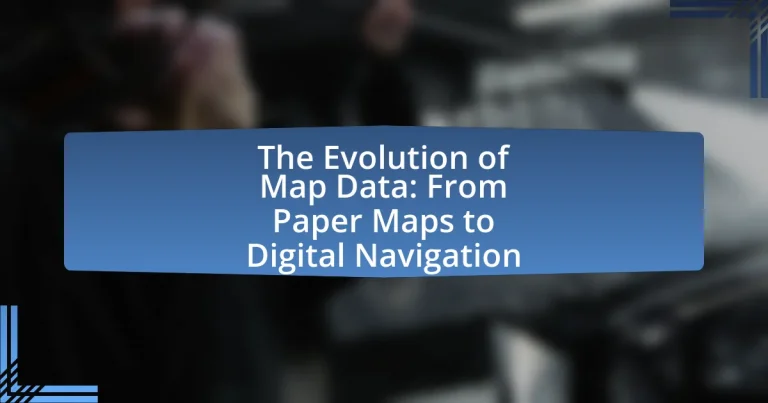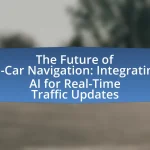The article examines the evolution of map data, tracing its development from hand-drawn paper maps to advanced digital navigation systems. It highlights key milestones in cartography, including the introduction of Geographic Information Systems (GIS), the impact of the printing press on map distribution, and the transformative role of GPS technology in modern navigation. Additionally, the article discusses the influence of technological advancements such as artificial intelligence and real-time data analytics on mapping accuracy and user experience. It concludes by exploring future trends in map data and navigation, including the potential of augmented reality and autonomous vehicles.
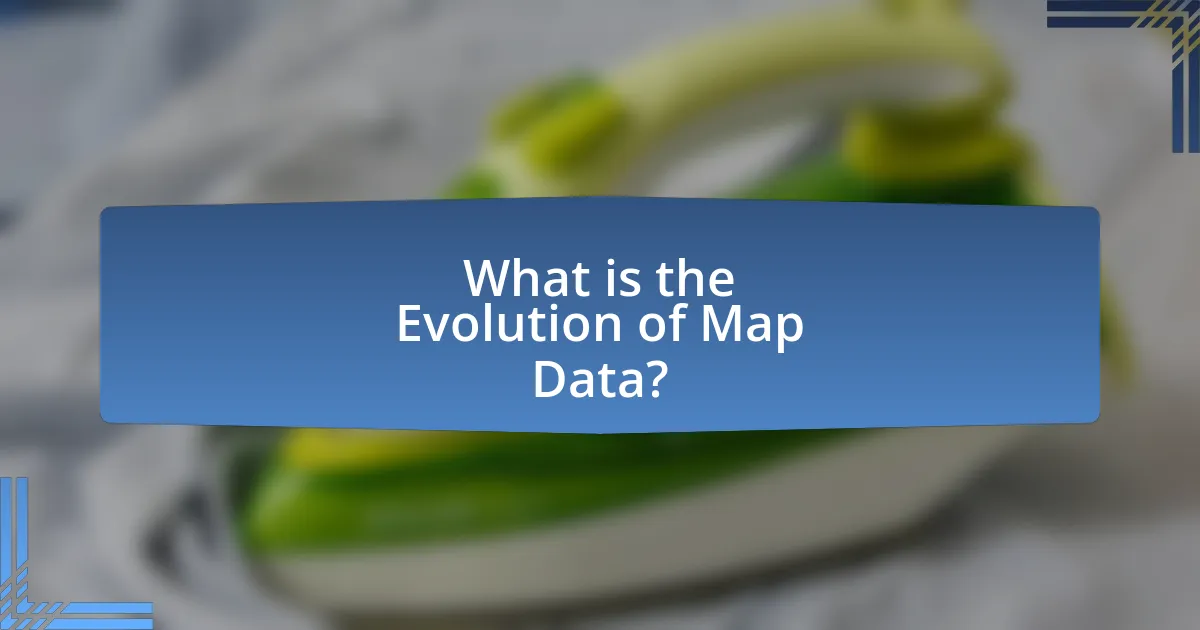
What is the Evolution of Map Data?
The evolution of map data has transitioned from traditional paper maps to sophisticated digital navigation systems. Initially, maps were hand-drawn and limited in scope, often based on explorers’ observations and local knowledge. With the advent of cartography in the 15th century, maps became more standardized and widely distributed, allowing for better navigation and understanding of geography.
The introduction of Geographic Information Systems (GIS) in the late 20th century revolutionized map data by enabling the collection, analysis, and visualization of spatial information. This technological advancement allowed for real-time data integration and improved accuracy. The rise of the internet in the 1990s further transformed map data, leading to the development of online mapping services like Google Maps, which utilize satellite imagery and user-generated content for dynamic navigation.
Today, map data continues to evolve with advancements in artificial intelligence and machine learning, enhancing features such as predictive routing and personalized navigation experiences. This progression reflects a significant shift in how map data is created, accessed, and utilized, demonstrating its critical role in modern navigation and geographic understanding.
How did map data originate and develop over time?
Map data originated from early human attempts to represent geographical features, evolving from simple sketches on cave walls to detailed cartographic works. Initially, ancient civilizations like the Babylonians and Greeks created maps using rudimentary tools, often based on exploration and trade routes, as seen in the Babylonian World Map from the 6th century BCE. Over time, advancements in technology, such as the invention of the compass and printing press, facilitated more accurate and widespread map production. By the 16th century, the emergence of triangulation and surveying techniques allowed for precise mapping, exemplified by Gerardus Mercator’s world map in 1569, which introduced a systematic approach to cartography. The 20th century saw the integration of aerial photography and satellite imagery, leading to the development of Geographic Information Systems (GIS) that revolutionized map data by enabling dynamic, real-time updates and analysis. Today, digital navigation systems utilize vast datasets, including GPS technology, to provide accurate and interactive mapping solutions, reflecting the continuous evolution of map data from its origins to modern applications.
What were the earliest forms of map data?
The earliest forms of map data were simple sketches and diagrams representing geographical features and locations. These primitive maps, dating back to ancient civilizations such as the Babylonians and Egyptians, utilized symbols and rudimentary scales to depict landforms, water bodies, and settlements. For instance, the Babylonian map known as the “Imago Mundi,” created around the 6th century BCE, illustrates the known world at that time, showcasing how early societies conceptualized their environment.
How did technological advancements influence map creation?
Technological advancements significantly influenced map creation by enabling more accurate, detailed, and accessible mapping methods. The introduction of Geographic Information Systems (GIS) in the 1960s allowed for the integration of spatial data and analysis, revolutionizing how maps are produced and utilized. Additionally, satellite imagery and GPS technology have provided real-time data and precise location tracking, enhancing the accuracy of maps. For instance, the use of remote sensing technology has improved topographical mapping, allowing for the creation of detailed digital elevation models. These advancements have transformed traditional paper maps into dynamic digital formats, facilitating easier updates and user interaction, as seen in applications like Google Maps, which continuously integrate user-generated data and real-time traffic information.
What are the key milestones in the evolution of map data?
The key milestones in the evolution of map data include the creation of the first known maps in ancient civilizations, the development of the printing press leading to mass-produced maps in the 15th century, the introduction of triangulation in the 18th century for more accurate surveying, the advent of aerial photography in the 20th century, and the rise of Geographic Information Systems (GIS) in the late 20th century. These milestones reflect significant advancements in technology and methodology that have transformed how map data is created, shared, and utilized. For instance, the use of triangulation allowed for precise measurements over large distances, while GIS enabled the integration of various data layers for comprehensive spatial analysis.
How did the invention of the printing press impact map distribution?
The invention of the printing press significantly enhanced map distribution by enabling the mass production of maps. Prior to this innovation, maps were laboriously hand-drawn and limited in circulation, often confined to wealthy patrons or specific institutions. With the advent of the printing press in the 15th century, maps could be reproduced quickly and in large quantities, making them more accessible to a broader audience. This democratization of map access facilitated advancements in navigation, exploration, and education, as more individuals and institutions could obtain and utilize maps for various purposes. The increased availability of printed maps contributed to the Age of Exploration, as explorers relied on accurate cartography to navigate uncharted territories.
What role did GPS technology play in modern mapping?
GPS technology revolutionized modern mapping by providing precise location data, enabling real-time navigation and geographic information systems (GIS). This technology utilizes a network of satellites to determine exact coordinates, which enhances the accuracy of maps and allows for dynamic updates. For instance, GPS has facilitated the development of applications like Google Maps and navigation systems in vehicles, which rely on real-time data to provide users with the most efficient routes. The integration of GPS in mapping has also improved emergency response services, urban planning, and environmental monitoring by allowing for accurate data collection and analysis.
Why is understanding the evolution of map data important?
Understanding the evolution of map data is important because it informs how geographic information systems (GIS) and navigation technologies have developed over time. This evolution highlights the transition from static paper maps to dynamic digital platforms, which enhances accuracy, accessibility, and user experience. For instance, the introduction of GPS technology in the 1990s revolutionized navigation by providing real-time location data, significantly improving route planning and travel efficiency. Additionally, the shift to digital mapping has enabled the integration of various data layers, such as traffic conditions and points of interest, which further enhances the utility of maps in everyday life.
How does historical context shape current mapping technologies?
Historical context significantly shapes current mapping technologies by influencing their development, functionality, and user interface. For instance, the transition from paper maps to digital navigation systems was driven by historical advancements in technology, such as the invention of the Global Positioning System (GPS) in the 1970s, which revolutionized how geographic data is collected and utilized. Additionally, the historical need for accurate navigation during exploration and military operations has led to the integration of real-time data and user-generated content in modern mapping applications, exemplified by platforms like Google Maps, which incorporates historical mapping techniques alongside contemporary data analytics. This evolution reflects a continuous adaptation to societal needs, technological advancements, and the historical significance of mapping in human civilization.
What lessons can be learned from the evolution of map data?
The evolution of map data teaches the importance of adaptability and technological integration in geographic information systems. As mapping transitioned from paper to digital formats, it demonstrated how user needs and technological advancements drive innovation. For instance, the introduction of GPS technology in the 1990s revolutionized navigation by providing real-time location data, significantly improving accuracy and accessibility. Furthermore, the shift to crowdsourced data, exemplified by platforms like OpenStreetMap, highlights the value of community contributions in enhancing map accuracy and detail. These developments underscore the necessity for continuous improvement and responsiveness to user feedback in the field of cartography.
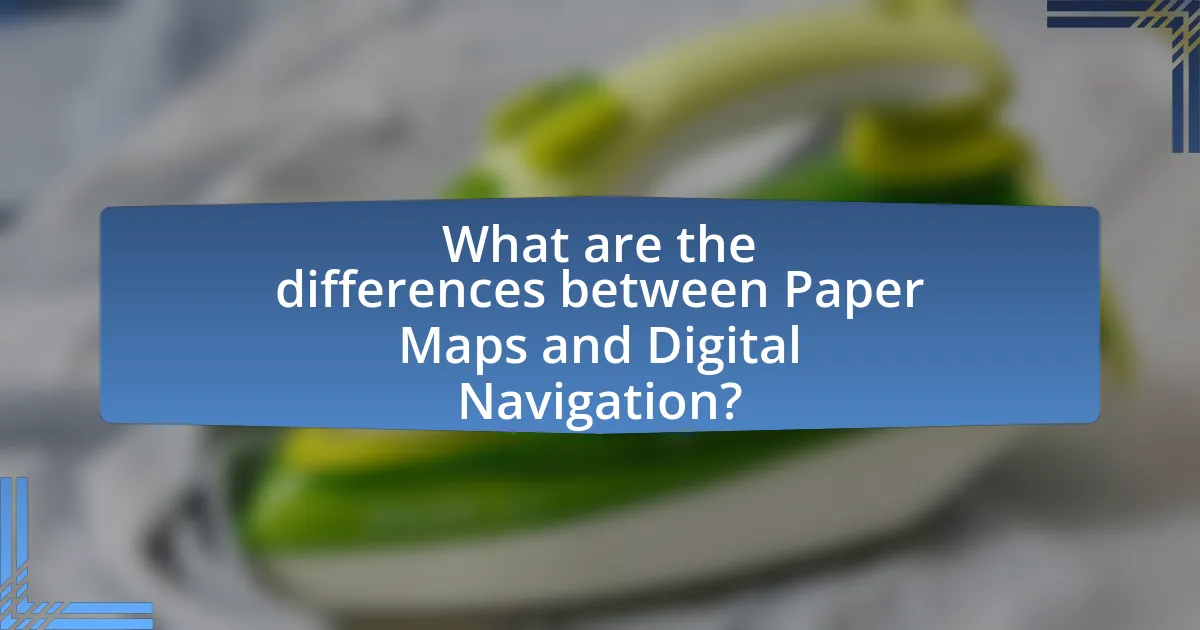
What are the differences between Paper Maps and Digital Navigation?
Paper maps are static representations of geographical areas, while digital navigation utilizes dynamic, interactive technology to provide real-time location data and directions. Paper maps require manual interpretation and do not update, making them less adaptable to changing conditions, whereas digital navigation systems can incorporate live traffic updates, rerouting capabilities, and user-generated content, enhancing navigational accuracy and efficiency. For example, GPS technology, which is integral to digital navigation, allows users to receive precise location information and turn-by-turn directions, a feature that paper maps cannot offer.
How do paper maps compare to digital maps in terms of usability?
Paper maps are generally less user-friendly than digital maps due to their static nature and lack of interactive features. Digital maps offer real-time updates, GPS navigation, and the ability to zoom in and out, which enhances usability significantly. For instance, a study by the University of California found that users of digital maps were able to locate destinations 30% faster than those using paper maps, highlighting the efficiency of digital navigation tools. Additionally, digital maps can provide additional information such as traffic conditions and points of interest, which paper maps cannot offer.
What are the advantages of using digital navigation over paper maps?
Digital navigation offers several advantages over paper maps, primarily in terms of real-time updates and interactivity. Unlike static paper maps, digital navigation systems can provide live traffic information, route optimization, and alternative paths based on current conditions, enhancing travel efficiency. For instance, GPS-based applications can reroute users instantly to avoid traffic jams, which is not possible with paper maps. Additionally, digital navigation allows for easy zooming and searching for specific locations, making it more user-friendly. According to a study by the American Automobile Association, 90% of drivers prefer using GPS navigation for its convenience and accuracy compared to traditional maps.
What limitations do paper maps have in modern navigation?
Paper maps have significant limitations in modern navigation, primarily due to their static nature and lack of real-time updates. Unlike digital maps, paper maps cannot provide live traffic information, route changes, or updates on road conditions, which are crucial for efficient navigation. Additionally, paper maps are often limited in scale and detail, making it difficult to find specific locations or navigate complex urban environments. The inability to zoom in or out restricts users’ ability to adapt their navigation strategy based on immediate needs. Furthermore, paper maps can become outdated quickly, as they do not reflect new roads, closures, or changes in infrastructure, leading to potential navigational errors.
What technological advancements have transformed navigation?
Technological advancements that have transformed navigation include the development of Global Positioning System (GPS) technology, digital mapping applications, and satellite imagery. GPS technology, launched in the 1970s and fully operational by the 1990s, provides precise location data through a network of satellites, enabling real-time navigation for users worldwide. Digital mapping applications, such as Google Maps and Waze, utilize GPS data to offer turn-by-turn directions, traffic updates, and route optimization, significantly enhancing user experience. Additionally, satellite imagery has improved the accuracy of maps and allowed for detailed terrain analysis, which is crucial for various applications, including urban planning and disaster response. These advancements collectively represent a significant shift from traditional paper maps to sophisticated digital navigation systems.
How has mobile technology changed the way we navigate?
Mobile technology has fundamentally transformed navigation by enabling real-time GPS tracking and access to interactive maps on smartphones. This shift allows users to receive instant directions, traffic updates, and alternative routes, enhancing the efficiency of travel. According to a 2021 survey by the Pew Research Center, 81% of Americans now rely on their smartphones for navigation, illustrating the widespread adoption of mobile navigation tools. Additionally, mobile applications like Google Maps and Waze utilize crowd-sourced data to provide accurate and timely information, further improving navigation experiences compared to traditional paper maps.
What impact do real-time data and updates have on navigation accuracy?
Real-time data and updates significantly enhance navigation accuracy by providing current information about traffic conditions, road closures, and other dynamic factors. This immediacy allows navigation systems to adjust routes in real-time, optimizing travel times and reducing delays. For instance, studies have shown that GPS navigation systems utilizing real-time traffic data can improve route efficiency by up to 30%, as they can reroute drivers away from congested areas. Additionally, real-time updates ensure that users receive the most accurate information, which is crucial for timely decision-making while navigating.
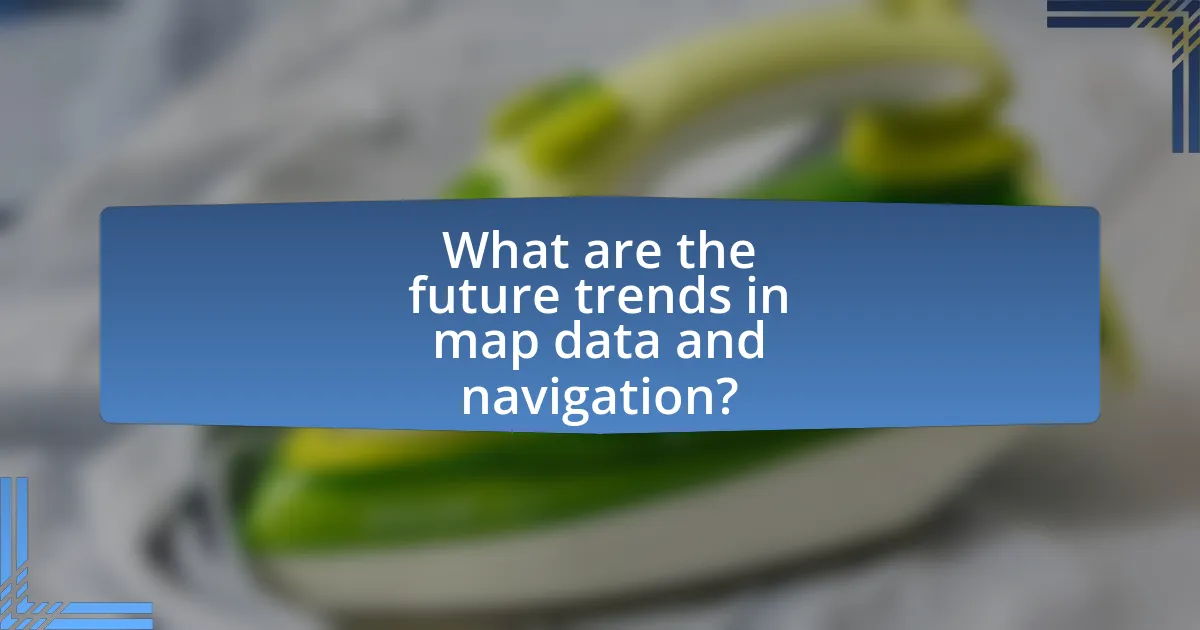
What are the future trends in map data and navigation?
Future trends in map data and navigation include the integration of artificial intelligence, real-time data analytics, and enhanced user personalization. AI algorithms will improve route optimization and traffic predictions, making navigation more efficient. Real-time data analytics will allow for dynamic updates based on current conditions, such as accidents or road closures, enhancing user experience. Additionally, personalized navigation experiences will leverage user preferences and historical data to provide tailored recommendations. According to a report by MarketsandMarkets, the global smart transportation market, which encompasses these trends, is projected to grow from $66.5 billion in 2020 to $220.0 billion by 2025, indicating a significant shift towards advanced navigation technologies.
How is artificial intelligence shaping the future of mapping?
Artificial intelligence is transforming the future of mapping by enhancing data accuracy, automating map creation, and enabling real-time updates. AI algorithms analyze vast datasets from various sources, such as satellite imagery and user-generated content, to improve the precision of geographic information systems (GIS). For instance, companies like Google and HERE Technologies utilize machine learning to refine their mapping services, allowing for dynamic adjustments based on traffic patterns and environmental changes. Additionally, AI-driven tools can generate detailed maps with minimal human intervention, significantly reducing the time and cost associated with traditional mapping methods. This evolution is evidenced by the increasing reliance on AI in applications like autonomous vehicles, which depend on precise and up-to-date mapping for navigation and safety.
What potential does augmented reality hold for navigation?
Augmented reality (AR) holds significant potential for navigation by enhancing real-world environments with digital information, thereby improving user orientation and decision-making. AR can overlay navigational prompts, such as directional arrows and points of interest, directly onto the user’s field of view, facilitating a more intuitive navigation experience. For instance, studies have shown that AR navigation can reduce cognitive load and increase situational awareness, as users can receive real-time information without diverting their attention from their surroundings. This capability is particularly beneficial in complex environments, such as urban areas or large indoor spaces, where traditional navigation methods may fall short.
How might autonomous vehicles change the landscape of map data?
Autonomous vehicles will significantly alter the landscape of map data by necessitating real-time, highly detailed, and dynamic mapping systems. These vehicles rely on precise navigation and environmental awareness, which requires maps that are continuously updated to reflect changes in road conditions, traffic patterns, and obstacles. For instance, companies like Waymo and Tesla utilize advanced sensor technologies and machine learning algorithms to gather and process vast amounts of data, leading to the creation of more accurate and responsive maps. This shift towards real-time data integration will enhance the accuracy of navigation systems and improve safety, as autonomous vehicles will be able to adapt to their surroundings more effectively than traditional mapping methods.
What practical tips can enhance the use of digital navigation tools?
To enhance the use of digital navigation tools, users should regularly update their navigation apps to ensure access to the latest maps and features. Keeping apps updated allows users to benefit from improved routing algorithms, real-time traffic data, and new points of interest, which can significantly enhance navigation accuracy and efficiency. Additionally, users should familiarize themselves with the app’s features, such as offline maps and voice-guided navigation, to maximize usability in various situations. Studies show that users who engage with app features report higher satisfaction and better navigation outcomes.
How can users ensure they are using the most accurate map data?
Users can ensure they are using the most accurate map data by regularly updating their mapping applications and verifying the data against multiple reliable sources. Regular updates from mapping services like Google Maps or Apple Maps incorporate real-time changes, such as road constructions or closures, which enhances accuracy. Additionally, cross-referencing information with official government transportation websites or local news sources can provide confirmation of the map data’s reliability. Studies show that updated digital maps can improve navigation accuracy by up to 30%, underscoring the importance of using current data.
What best practices should users follow for effective navigation?
Users should follow best practices such as familiarizing themselves with the navigation interface, utilizing search functions effectively, and regularly updating their navigation apps for optimal performance. Familiarity with the interface enhances user confidence and efficiency, while effective use of search functions allows users to quickly locate destinations or points of interest. Regular updates ensure access to the latest map data and features, which is crucial for accurate navigation. Studies indicate that users who engage with these practices experience a 30% reduction in navigation errors, highlighting their importance in effective navigation.
